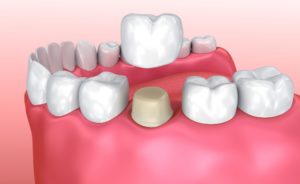A dental crown is a porcelain or ceramic dental appliance that a dentist uses to support your teeth. Typically, you would need a crown after a root canal procedure or due to a broken tooth. If you need a root canal or a large filling, it means that you likely had tooth decay. To remove the decay, your dentist must use a drill to excavate the destroyed portion of your tooth.
In several cases, the dentist must remove a large portion of your tooth. Even with a filling, there might not be enough of your tooth left to support itself. Therefore, your dentist may utilize a crown to give your tooth structure and support.

Dental Crown Procedure
Before your dentist begins the crown procedure, they will take an x-ray of your mouth. This allows them to see the complete picture of your tooth. Additionally, it will enable them to see if there is any other damage that they need to address. For example, having a broken tooth means you need a crown. Therefore, it is vital for your dental team to view your tooth through an x-ray to see the full extent of the damage.
Once they see your tooth and make a dental plan, they will numb the area. Next, they will inject your gums with a local anesthetic. This will ensure that you don’t feel any pain during your procedure, making the process smooth and painless.
Next, your dentist must prepare your tooth for the dental crown. If you have an infection or decay, they will need to remove the decay before this step. To prepare the tooth, they will file or shave it down using a special dental tool. The tooth must be the correct size and shape for the crown. Otherwise, it can create a bad bite or malocclusion after they place the crown.
If you are getting a traditional crown, you will need a temporary crown while your permanent crown is made. However, your dentist will take an impression of your tooth to create your permanent crown. While a lab creates your crown, you will receive a temporary crown. After about two weeks, you will return to get your permanent crown.
To secure the crown, your dentist will use a special dental cement.
Caring for Your Crown Post-Procedure
After your procedure, your mouth may still be numb for a few hours. While your mouth is numb, you should be careful while eating so that you don’t bite your tongue or hurt your teeth.
Once the anesthetic wears off, you may experience some mild discomfort or swelling. If that happens, you can take some over-the-counter painkillers, such as Tylenol or Advil. This will help reduce the pain or swelling. You shouldn’t feel any sharp or extreme pain following your procedure. If you do, you need to contact your doctor as soon as possible.
You will brush and floss your teeth like normal. However, you should take care when you floss your teeth so that you don’t get the floss stuck under the crown.
